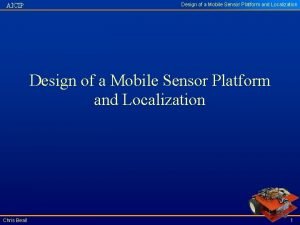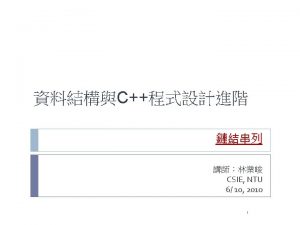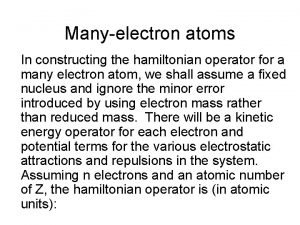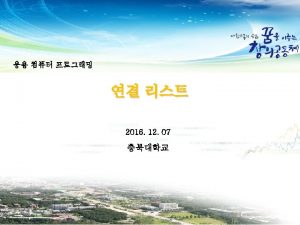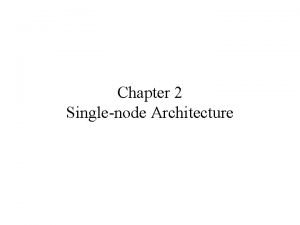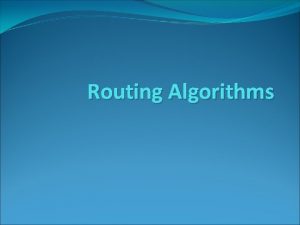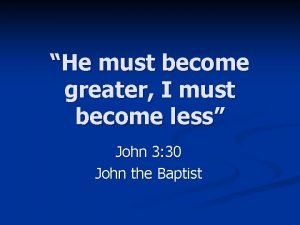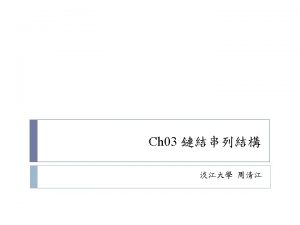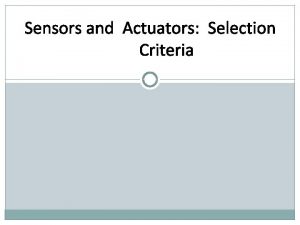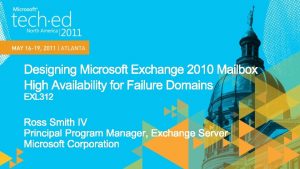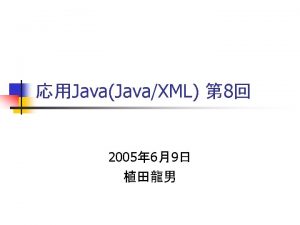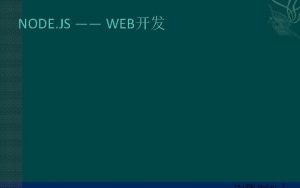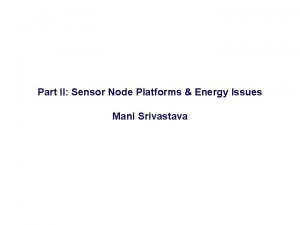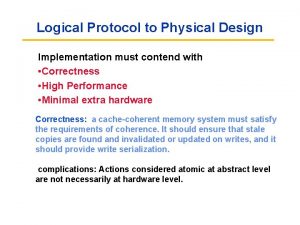Overview Chapter 7 Sensor node platforms must contend










- Slides: 10

Overview: Chapter 7 Sensor node platforms must contend with many issues Energy consumption Sensing environment Networking Real-time constraints Not typical distributed system application Programming Models Programs by end users Encode application logic Abstract details from users Programs by application developers Expose data acquisition and hardware interface to developers

Sensor Node Hardware Categories Augmented general purpose PC 104, Sensoria WINS NG, PDAs Commercial off-the-shelf (COTS) OS & components: Wndows CE, Linux, Bluetooth, IEEE 802. 11 Dedicated embedded sensor nodes Berkeley motes, UCLA Medusa, Ember nodes, MIT AMP COTS chip sets (small form factors), programming languages(e. g. , C) System-on-chip (So. C) Smart dust, BWRC picoradio nodes, PASTA nodes

Berkeley Motes Limited memory Program memory: 8 - 128 KB RAM: 0. 5 - 4 KB External storage (Flash): 32 - 512 KB Limited Communication Max 50 kbps (with hardware acccel. ) Energy savings is important 12 m. A to transmit data

Programming Challenges Traditional programming models not suitable Programmer must handle with messaging, networking, event synch. , interrupts etc. Embedded OS (if any) expose hardware details to programmer Distributed algorithms/data structures difficult to implement Respond to multiple stimuli quickly

Software Platforms: Tiny. OS Targeted for resource constrained platforms (motes) Small memory footprint No filesystem Only static memory allocation Software made up of components Components create tasks and added to task scheduler Tasks run to completion: no preempting by other tasks Events: interrupts from hardware Run to completion, can preempt tasks

Software Platforms: nes. C Extension of C for Tiny. OS Components Interface Defines what functionality component uses and provides Implementations Modules: written in C-like syntax Configurations: connect interfaces of existing components Cuncurrency Asynchronous code (AC) vs. Synchronous code (SC) SC atomic w. r. t. other SC Programmers must understand concurrency issues in code

Software Platforms: Tiny. GALS Dataflow language Programming model Supports all Tiny. OS components Construct asynch. actors from synch. components Construct application by connecting asynch. components through FIFO queues Code Generation Map high-level constructs to low-level code for motes Automatically generate code for scheduling, event handling, FIFO queues

Node-Level Simulators Sensor node model Mobility of nodes Energy consumption Communication model Capture details of communication (RF propagation delay, MAC layer etc. ) Physical environmental model Model physical phenomena in operating environment Statistics and visualization Collect results for analysis

Node-Level Simulator: ns-2 & TOSSIM ns-2 Originally developed for wired networks Extensions for sensor nodes Node locations vs. logical addresses Energy models Physical phenomena TOSSIM Simulator for Tiny. OS apps on Berkeley motes Compiles nes. C source into simulator components

State-Centric Programming Applications more than simple distributed programs Applications depend on state of physical environment Collaboration Groups Set of entities that contribute to state updates Abstracts network topology and communication protocols Multi-target tracking problem Global state decoupled into separate pieces Each piece managed by different principal State updated by looking at inputs from other principals Collaboration groups define communication and roles of each principal
 Mobile sensor platforms
Mobile sensor platforms Reference node and non reference node
Reference node and non reference node Reference node and non reference node
Reference node and non reference node Wavelength constructive interference
Wavelength constructive interference Typedef struct in c
Typedef struct in c Hamiltonian operator
Hamiltonian operator Struct node int data struct node* next
Struct node int data struct node* next Single node architecture in wireless sensor networks
Single node architecture in wireless sensor networks Two node loop instability
Two node loop instability I must become less
I must become less Chapter 17 maintaining your vehicle answers
Chapter 17 maintaining your vehicle answers
